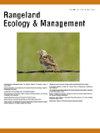量化地中海鹿日粮植物成分的两种显微组织学分析的可靠性
IF 2.4
3区 环境科学与生态学
Q2 ECOLOGY
引用次数: 0
摘要
显微组织学分析是研究草食动物饮食组成的有力技术,但它涉及到对所消耗的植物物种的正确识别和有效的相对定量,以及对方法固有的可能偏差的认识。我们分析了用实验程序从实验室制备的样品中定量植物角质层相对频率的两种方法。分析了影响定量精度的因素,估计了检测实验混合物中所有植物的最小采样工作量,并讨论了在复杂真实样品上的实际应用,以描述一种简单、标准化和可靠的方法来研究地中海生态系统草食动物饮食组成。用40种已知植物按不同数量和干重百分比组合,随机配制10种混合物。使用两种定量方法对分布在每个样品5张载玻片上的共100个显微场进行分析。统计分析表明,两种方法差异显著。该方法通过对每个显微场中每种植物的存在/缺失进行标注,而不是对每个显微场中每种植物的总检测次数进行标注,获得了更高的精度。准确度的重要预测因子是样品的复杂性和混合物中植物材料的比例。载玻片和显微镜视野的数量对定量结果没有显著影响,在最复杂的样品中,没有发现超过25个视野的额外物种。由于其更高的可靠性、更短的分析时间和更少的视觉努力,第一种方法被证明是更有效的。该方法在过度丰富的鹿群和放养家畜的饮食研究中得到了验证和应用,以评估草食动物对生态系统的影响,并在利用牧场实现环境和经济可持续性方面制定可持续管理标准。本文章由计算机程序翻译,如有差异,请以英文原文为准。
Reliability of Two Microhistological Analyses for Quantifying the Botanical Composition of Mediterranean Deer Diets
Microhistology analyses are well-supported techniques useful for studying herbivore diet composition, but they involve the correct identification and validated relative quantification of the plant species consumed, as well as the knowledge of possible biases inherent to methods. We analyzed two methods for quantifying the relative frequency of plant cuticles using an experimental procedure from laboratory-prepared samples. The factors affecting the precision of quantification were analyzed, the minimum sampling effort to detect all plants in the experimental mixture was estimated and the practical application on a complex real sample discussed, in order to describe a simple, standardized, and reliable procedure for studies of herbivore diet composition in Mediterranean ecosystems. Ten random mixtures were prepared with combinations of 40 known plant species, in different number and dry weight percentages. A total of 100 microscopic fields, distributed across 5 slides per sample, were analyzed using both quantification methods. Statistical analysis concluded that the two methods differed significantly. Higher precision was achieved with the method based on annotating the presence/absence of each species in each microscopic field, instead of the total number of times each plant was detected in each field. The important predictors of accuracy were the complexity of the sample and the proportion of plant material in the mixtures. The number of slides and microscopic fields did not significantly impact the quantification results, and no additional species were identified beyond 25 fields in the most complex samples. Due to its greater reliability, shorter analysis time, and reduced visual effort, the first method proved to be more efficient. This method is validated and useful in diet studies of overabundant populations of deer and extensive and transhumant livestock to evaluate the impacts of herbivores on ecosystems and generate sustainable management criteria in the use of pastures toward environmental and economic sustainability.
求助全文
通过发布文献求助,成功后即可免费获取论文全文。
去求助
来源期刊

Rangeland Ecology & Management
农林科学-环境科学
CiteScore
4.60
自引率
13.00%
发文量
87
审稿时长
12-24 weeks
期刊介绍:
Rangeland Ecology & Management publishes all topics-including ecology, management, socioeconomic and policy-pertaining to global rangelands. The journal''s mission is to inform academics, ecosystem managers and policy makers of science-based information to promote sound rangeland stewardship. Author submissions are published in five manuscript categories: original research papers, high-profile forum topics, concept syntheses, as well as research and technical notes.
Rangelands represent approximately 50% of the Earth''s land area and provision multiple ecosystem services for large human populations. This expansive and diverse land area functions as coupled human-ecological systems. Knowledge of both social and biophysical system components and their interactions represent the foundation for informed rangeland stewardship. Rangeland Ecology & Management uniquely integrates information from multiple system components to address current and pending challenges confronting global rangelands.
 求助内容:
求助内容: 应助结果提醒方式:
应助结果提醒方式:


